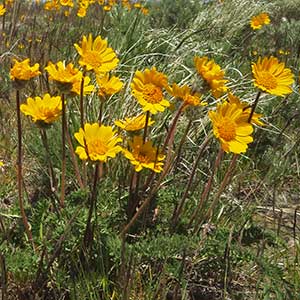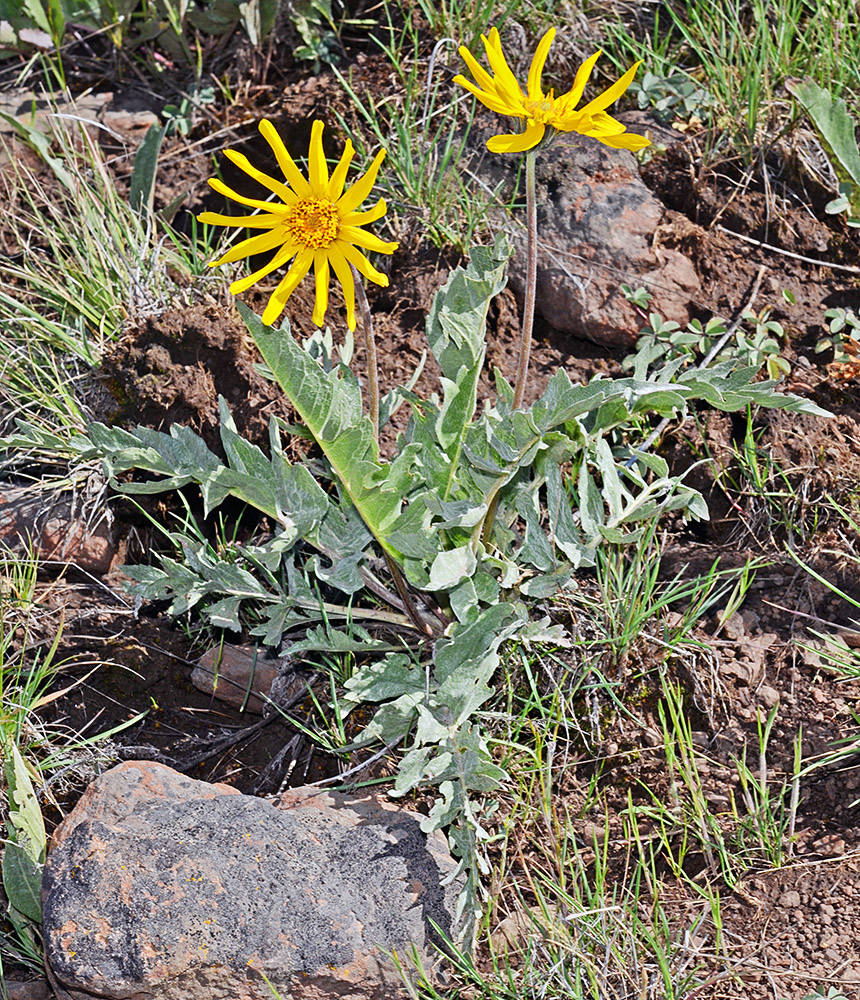Balsamorhiza hookeri
Balsamorhiza incana
Hooker's balsamroot
hoary balsamroot, woolly balsamroot
11–47 cm; hirsute; from single taproot.
9–43 cm, tomentose; from single taproot.
lanceolate to ovate-lanceolate, 1-pinnately divided with some pinnae toothed or lobed to 3-pinnately lobed;
margins entire to crenate or serrate;
surfaces hirsute to hirsute-sericeous;
basal leaves in 1–few rosettes;
blades 12–24 × 4–12 cm;
pinnae 1–10 mm wide;
petioles 4–15 cm;
cauline blades 3–14.5 × 0.6–4 cm;
petioles 4–11 cm.
ovate-lanceolate, 1-pinnately divided;
margins toothed, especially distally, sometimes also on proximally;
surfaces tomentose and often lacking glands;
basal leaves in 1–few rosettes;
blades 11–22 × 5–8.5 cm;
pinnae 5–15 mm wide;
petioles 4–17 cm;
cauline leaves in 1 pair, sometimes very near base of stem;
blades 1.5–9.5 × 0.6–4.5 cm;
petioles 4–8 cm.
with 1 terminal head.
with 1 terminal head.
8–15 × 15–25 mm.
11–18 × 18–28 mm.
deciduous, 10–17, yellow;
rays 15–30 × 4–7 mm.
deciduous, 13–22, yellow;
rays 25–35 × 7–10 mm.
~6 mm.
7.5–9 mm.
linear-lanceolate to ovate, 13–20 × 3–6 mm, with or without long-acuminate tips, villous-hirsute and ciliate, sometimes glabrous proximally.
lanceolate, 15–20 × 3–5 mm;
tips acuminate.
6.5 × 1.5 mm, glabrous.
5–6 mm, glabrous.
11–12 mm.
~10 mm.
=38.
=38.
Balsamorhiza hookeri
Balsamorhiza incana
Dry, open, often rocky areas. Flowering Apr–Jun. 1000–1600 m. BR, BW. CA, ID, NV, WA; southeast to UT. Native.
As treated here, B. hookeri consists of the members of section Balsamorhiza that are left over after the entities that are distinct in at least some parts of their ranges are removed. Balsamorhiza hookeri hybridizes with B. hispidula and B. sagittata. The species is named after the British botanist William Jackson Hooker, who initially described it as Heliopsis balsamorhiza and tentatively proposed (but did not validly publish, as he did not accept it) the genus Balsamorhiza under the supposition that it would prove to be distinct from Heliopsis once better material was collected.
Open, rocky areas. Flowering Apr–Jun. 300–1500 m. BW, Col. ID, WA; east to WY. Native.
Balsamorhiza incana is unusual among species of section Balsamorhiza in remaining fairly distinct throughout its wide range. It occurs generally north and east of the widespread B. hispidula/B. hookeri complex. Its hybrids with B. sagittata have been given the name B. × tomentosa. The specific epithet refers to the whitish appearance from the dense pubescence.
Abigail (Abby) Moore
Abigail (Abby) Moore





